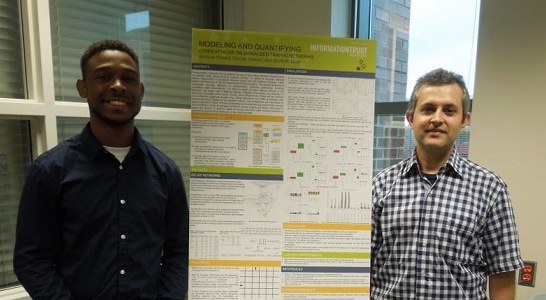Meet Dr. Gurcan Comert & Jacquan Malik Deontrez Pollard
Faculty-student team investigated the security of transportation networks used for connected and autonomous vehicles
Self-driving vehicles are a rapidly growing technology being tested under various state and local highway regulations. In June 2017, the U.S. Congress voted on a bill that would allow further progression of autonomous vehicles at the federal level.

Dr. Gurcan Comert & Jacquan Malik Deontrez Pollard's research contributed to advancements in the security of transportation networks for connected and autonomous vehicles for urban areas.
While proliferation of self-driving vehicles may be part of the future, serious safety and security considerations must be addressed before these vehicles hit the streets nationally. One of these concerns is the potential of a cyberattack to an operating system, compromising the security of traffic networks.
Recently Jacquan Malik Deontrez Pollard, a junior electrical engineering student at Benedict College, and Gurcan Comert, Ph.D., a professor at Benedict College, explored these safety and security efforts through their participation in the U.S. Department of Homeland Security (DHS) Summer Research Team (SRT) Program for Minority Serving Institutions.
The program aims to increase and enhance the scientific leadership at Minority Serving Institutions in research areas that support the DHS mission and goals. It provides faculty and student research teams the opportunity to conduct research at the university-based DHS Centers of Excellence (DHS Centers). The SRT Program and DHS Centers are sponsored by the DHS Science and Technology Directorate Office of University Programs.
Comert was eager to dive into the security considerations for self-driving vehicles, as well as learn from and collaborate with experts in the field from other universities. Pollard welcomed the opportunity to join the research program and collaborate with his professor.
Comert and Pollard’s research was focused on the security of transportation networks for connected and autonomous vehicles. Connected vehicles are vehicles that use any number of different types of communication technologies. These technologies include communication with the driver, other cars on the road and roadside infrastructure. A fully autonomous vehicle is one that does not require a human driver. There are also vehicles that are considered to be semi-autonomous, meaning that they contain some level of autonomous functionality, such as self-parking or auto-collision avoidance.
Transportation networks are considered to be some of the most critical cyber-physical infrastructures for urban areas. Connected and autonomous vehicles offer benefits of increased traffic safety and efficiency, but they are inherently vulnerable to different kinds of cyberattacks. Comert and Pollard sought to model and quantify the likelihood of cyberattacks to identify risks and possible mitigation techniques.
The team collaborated with David Nicol, Ph.D., director of the Information Trust Institute (ITI) of the University of Illinois at Urbana-Champaign. The team focused on traffic signal networks because these are the most used form of traffic control in urban areas. Pollard and Comert worked to simulate, develop and test detection models for system control failures, and they simulated possible attack scenarios. To do this, the team evaluated risk areas and impacts of attacks by traffic simulations. Based on the assumed levels of traffic and possible attack areas, risk probabilities were calculated. The impacts of possible attacks were then quantified in terms of average number of vehicles delayed at an intersection and the seconds per vehicle for each delay.
The team’s research contributed to advancements in the security of transportation networks for connected and autonomous vehicles for urban areas. Overall, connected and autonomous vehicle systems are thought to improve automotive safety, increase efficiency and reduce fuel consumption and emissions.
“My overall impression of this experience was amazing because of the degree of hospitality and welcoming I received from the hosting faculty and students. Yes, I would recommend it to others,” Pollard said. “Coming (to) a university setting with so many people of various cultural backgrounds granted me the opportunity to learn more about their respective countries’ culture, cuisine and daily activities. One of my favorite parts of this program was working alongside undergraduate and graduate students of various ethnic and cultural backgrounds.”
Comert appreciated the experience for the one-on-one time he spent with Pollard as they addressed the research problems. The program enabled him to collaborate with Nicol, a professional familiar to him from early in his collegiate career. “During my studies for an undergraduate degree in industrial engineering, I was taught a simulation course entirely from Nicol’s book, 3rd edition. I used it during my Ph.D. study. So, it is amazing that after about 17 years and two editions later, I was able to work with him in person,” said Comert.
The team intends to prepare a manuscript and submit it to the journal, Expert Systems with Applications. In the future, the team would like to continue its research with more sophisticated models.
“The experience itself is unmatched. It has broadened our view. This program opens a new avenue for us at Benedict College,” said Comert.
The DHS SRT Program is funded by DHS and administered through the U.S. Department of Energy’s (DOE) Oak Ridge Institute for Science and Education (ORISE). ORISE is managed for DOE by Oak Ridge Associated Universities.
